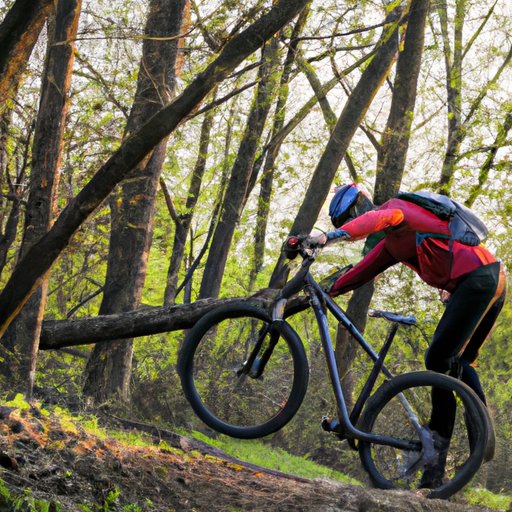Introduction
Mountain biking is an exciting outdoor activity that can be enjoyed by adventurers of all skill levels. However, before taking on a challenging mountain bike trail, it’s important to be prepared with the right gear and knowledge. This article will provide a step-by-step guide to riding a mountain bike trail safely and effectively.

Research the Mountain Bike Trail and its Difficulty Level
The first step in preparing for a mountain bike trail is to research the location of the trail and its difficulty level. You can find information about trails in your local area from websites such as Trailforks or MTB Project. Once you’ve identified a trail, read reviews and descriptions of the trail to get a better understanding of what to expect. It’s also important to assess the difficulty level of the trail and make sure it’s within your skill level. If you’re a beginner, start with an easier trail and work your way up.
Prepare Your Bike for the Trail
Once you’ve chosen a trail, it’s time to make sure your bike is ready to go. Before heading out, inspect your bike for any damages or problems. Check the brakes, tires, chain, and other components to make sure everything is functioning properly. Make any necessary repairs or adjustments before hitting the trail. Additionally, if you’re planning on tackling a more difficult trail, consider making upgrades to your bike such as wider tires, stronger brakes, or better suspension.
Wear Appropriate Safety Gear
It’s important to wear the proper safety gear when riding a mountain bike trail. At the very least, you should always wear a helmet and knee pads. Helmets are designed to protect your head from impacts and falls, while knee pads help protect your knees from scrapes and bruises. Other safety gear you may want to consider include gloves, elbow pads, and eye protection.
Warm Up Before Riding
Before you hit the trail, it’s important to do some warm-up exercises to prepare your body for the physical demands of mountain biking. Start by doing some light stretching to loosen your muscles and improve your range of motion. You can also do some dynamic stretches such as jumping jacks or arm circles to get your heart rate up. These exercises will help prevent injuries and make your ride more enjoyable.

Start Out Slow and Practice the Basics
Once you’re warmed up, it’s time to start riding. Begin by practicing the basics, such as braking, cornering, and shifting gears. Focus on mastering these fundamental skills before moving on to more advanced techniques. Take your time and focus on building your confidence and comfort level on the trail. As you become more comfortable, you can gradually increase your speed and take on more challenging terrain.

Learn Proper Techniques for Navigating the Terrain and Obstacles
As you gain more experience, you’ll need to learn proper techniques for navigating different types of terrain and obstacles. For example, when going downhill, you’ll need to learn how to maintain control of your bike while keeping your speed in check. When approaching a jump, you’ll need to learn how to launch off and land properly. Learning these techniques will help you ride more confidently and safely.
Take Frequent Breaks
When riding a mountain bike trail, it’s important to take frequent breaks to catch your breath and assess your progress. This will help you stay focused and avoid fatigue. Take a few minutes to rest and enjoy the scenery, then get back on your bike and keep pushing forward.
Conclusion
Riding a mountain bike trail can be a fun and rewarding experience. To ensure a safe and successful ride, it’s important to research the trail and its difficulty level, prepare your bike, wear appropriate safety gear, warm up before riding, practice the basics, learn proper techniques for navigating the terrain and obstacles, and take frequent breaks. By following these steps, you’ll be well on your way to becoming a skilled mountain biker.


